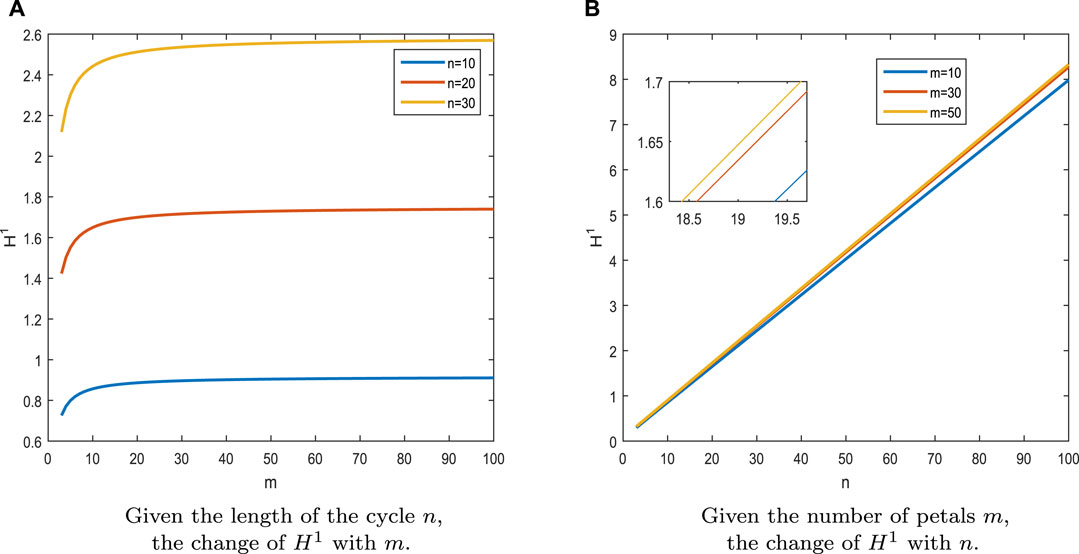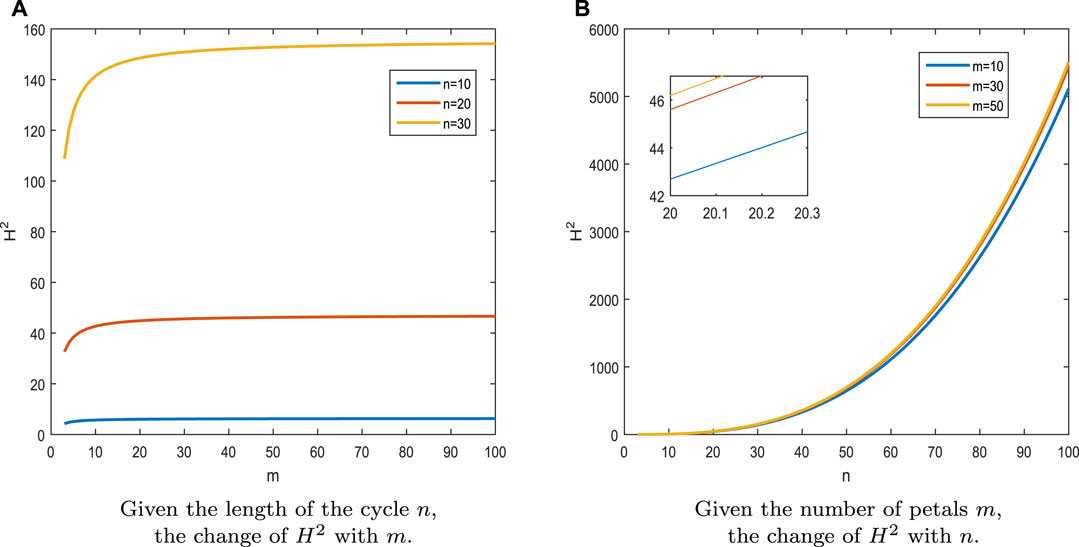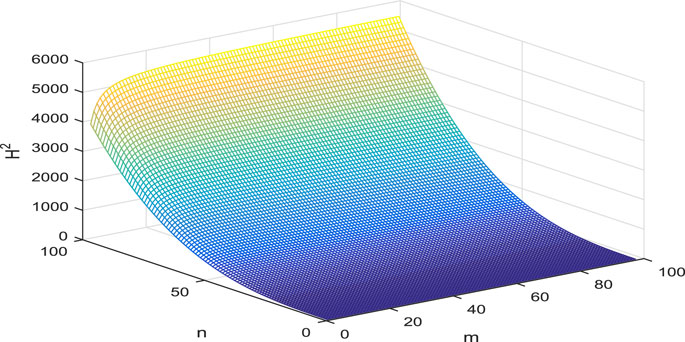- 1Research Center for Vocational and Technical Education, Xinjiang Institute of Engineering, Urumqi, Xinjiang, China
- 2Department of Mathematics and Physics, Xinjiang Institute of Engineering, Urumqi, Xinjiang, China
- 3Department of Basic Science, Xinjiang Institute of Light Industry Technology, Urumqi, Xinjiang, China
- 4Department of Computer and Software Engineering, Xihua University, Chengdu, Sichuan, China
The consensus of deterministic networks investigates the relationships between consensus and network topology, which can be measured by network coherence. The m-rose networks are composed of m circles, which share a common node. Recently, scholars have obtained the first-order coherence of 5-rose networks. This paper takes the more general m-rose networks as the research object, firstly, the m-rose networks are introduced. Secondly, the relationships between Laplacian eigenvalues and polynomial coefficients are used to obtain the first-order and second-order coherence of the m-rose networks. Finally, the effects of topology parameters such as the number of petals m and the length of a cycle n on the robustness of network consensus are discussed, and the validity of the conclusion is verified by numerical simulation.
1 Introduction
With the development of network science, the study of network dynamics has become a hot spot. There are many networks in the real world, such as social networks [1], supply chain networks, and ecological networks [2–4]. The study of networks can solve practical problems in computer science, mathematical science, control science, and many other disciplines. With the deepening of research, network research has made new progress in many aspects, such as network synchronization [5–8], node containment control [9], network consensus, and robustness [10–13].
The problem of network consensus studies how multiple individuals in the network achieve consensus in direction, and location, which has potential applications in sensor networks, communication control, and other aspects [14, 15]. The consensus of the network can be measured by the network coherence, which can be quantified by the Laplacian spectrum of the network [16]. Reference [17] investigated the first-order coherence of three types of symmetric star networks and found that the increase in branch length and the number of branches of star networks will weaken the consensus of three types of networks. Reference [18] studied the consensus of scale-free networks with noise and found that the average degree of node dynamics has a great impact on the network consensus. Reference [19] deduced the consensus problems for a group of agents with heterophyllous dynamics, which can arouse future research in synchronization processes over heterophyllous multiagent networks.
The advantage of a deterministic network is that the coherence can be solved, so it can promote the in-depth study of practical network models. Reference [20] studied the consensus in a deterministic network model given the initial state of the leader points. As a kind of deterministic network, the m-rose networks have attracted the attention of scholars. Reference [21] proved that the 3-rose networks are determined by the Laplacian spectrum by calculating the quadratic coefficients of the Laplacian polynomial corresponding to the 3-rose networks. Reference [22] obtained the first-order coherence of the 5-rose networks by using the Laplacian spectrum and investigated the effect of the number of petals on the consensus.
Inspired by the above literature, this paper analyzes the robustness of consensus of the m-rose networks, which is more applicable. The first and second-order coherence of the m-rose networks is obtained by computing the Laplacian polynomials. It was found that the topological structure parameters have a significant impact on the robustness of the consensus of the m-rose networks. The main innovation is as follows.
1. Compared with Ref. [22], this paper extends the 5-rose networks to more general m-rose networks, eliminating the limitation of network cycles and expanding its practical application range.
2. Due to the difficulty in solving the Laplacian spectrum of the m-rose networks, we apply the Laplacian theorem and iterative methods to obtain the Laplacian polynomial of the m-rose networks, and then get the coherence of the m-rose networks.
3. The effect of the number of petals m and the length of a cycle n on the consensus of the m-rose networks was considered, and it was found that the smaller the topological parameters m and n, the better the consensus of the networks.
2 Preliminaries
2.1 The Laplacian eigenvalues of network The Laplacian matrix of network
G with S nodes is defined as L(G) = M(G) − A(G), where M(G) = diag (m1, m2, m3, … , mS−1, mS), mi denotes the degree of node i.
2.2 network coherence
In reality, the network will inevitably be disturbed by noise, and the state of the network nodes will deviate from the consistent state. At this time, network coherence is used to measure the network consensus. To investigate how noise affects network consensus, the first-order consensus dynamic model under noise interference is described as follows [18]:
x(t) ∈ RS is the state vector, L represents the Laplacian matrix, ρ(t) ∈ RS denotes the Gaussian white noise interference of S nodes at time t. The first-order network coherence is defined as:
where var represents variance.
Define the output of system (1) as:
where
Combined with (1) and (2), H1 can be expressed as
where tr represents the trace of the matrix.
From [18], the relationships between the first-order network coherence and the Laplacian eigenvalues are described as follows:
Meanwhile, let x1(t), x2(t) be the velocity vector and the position vector, respectively. The second-order consensus dynamic model under noise interference is described as follows [10]:
From [10], the relationships between the second-order network coherence and the Laplacian eigenvalues are described as follows:
The network coherence H1 and H2 measures the robustness of the system subject to the noise. Lower H1 and H2 means that nodes reach better consensus at the average of their current states.
2.3 The m-rose networks
The m-rose networks are a generalization of friendship networks, which are composed of m circles, and m circles have a common node [23]. In this paper, we study m-rose networks R (m, n) with the length of the cycle n, which have mn − m + 1 nodes and mn edges. R (6, 10) is shown in Figure 1.
3 The coherence of m-rose networks R (m, n)
To obtain the coherence of R (m, n), this paper first obtains the Laplacian polynomial of 6-rose networks R (6, n), and gets the Laplacian polynomial of m-rose networks R (m, n) through a similar method. According to the relationships between polynomial coefficients and eigenvalues, the coherence of R (m, n) is further calculated.
Let the Laplacian matrix corresponding to R (6, n) be L, combined with the definition of the Laplacian matrix and the topological structure of R (6, n). The Laplacian polynomial of R (6, n) is Q1(λ) = |λI − L|, Q1(λ)
then,
Where M6n−5(λ) =
Let the Laplacian matrix of R (m, n) be L*, similar to solving the Laplacian polynomial of R (6, n), the Laplacian polynomial of R (m, n) is Q2(λ) = |λI − L*|,
Theorem 1. The first-order coherence of m-rose networks R(m, n) is
Proof. Let 0 < α1 ≤ α2 ≤ ⋯ ≤ αn−1 be the Laplacian eigenvalues of Pn−1(λ), Pn−1(λ) = an−1λn−1+ an−2λn−2 + ⋯ + a1λ + a0, 0 = β1 < β2 ≤ β3 ≤ ⋯ ≤ βn be the Laplacian eigenvalues of Kn(λ), Kn(λ) = (λ − 2m)Pn−1(λ) − 2mPn−2(λ) + (−1)n+12m = bnλn + bn−1λn−1 + ⋯ + b1λ.According to preliminaries,
According to [17] and the Vieta theorem,
Theorem 2. The second-order coherence of m-rose networks R(m, n) is
Proof. According to preliminaries,
According to [20] and the Vieta theorem,
4 Numerical simulation
Figures 2A, 3A) shows the relationships between H1(H2) and the number of petals m. When n is fixed, H1(H2) is positively correlated with the number of petals m and increases at a decreasing rate. The smaller the length of the cycle n is, the smaller H1(H2) is. The consensus of the network is inversely proportional to the coherence, so as the number of petals of the m-rose networks increases, the first-order (second-order) consensus of the network decreases. If the number of petals m is sufficiently large, H1(H2) will tend to a constant value and the consensus reaches its weakest.

FIGURE 2. (A) Given the length of the cycle n, the change of H1 with m (B) Given the number of petals m, the change of H1 with n.

FIGURE 3. (A) Given the length of the cycle n, the change of H2 with m. (B) Given the number of petals m, the change of H2 with n.
Figures 2B, 3B shows the relationships between H1(H2) and the length of the cycle n. When m is fixed, H1(H2) is positively correlated with the length of the cycle n. The smaller the number of petals m is, the smaller H1(H2) is. Therefore, when the length of the cycle of m-rose networks increases, the first-order (second-order) consensus of the network decreases.
Figure 4 shows the relationships between H2 and the number of petals m and the length of the cycle n. It is found that the influence of the length of the cycle n on the coherence is stronger than the number of petals m. A similar conclusion is drawn for the first-order consensus of the m-rose networks.
5 Conclusion
In this paper, the robustness of the consensus of m-rose networks is studied. Using the Laplacian theorem and determinant properties, the concrete analytical expressions of the first-order and second-order coherence of m-rose networks are obtained. Based on the analytical formula, the effects of the number of petals m and the length of the cycle n of the network on the consensus are simulated experimentally. When the length of the cycle n is fixed, the consensus of the m-rose networks will weaken with the increase of the number of petals m. The smaller the length of the cycle n, the stronger the robustness of consensus. When the number of petals m is fixed, the consensus of the m-rose network will weaken with the increase of the length of the cycle n. The smaller the number of petals m, the stronger the robustness of consensus. When the number of petals m and the length of the cycle n both increase, the consensus decreases, and the impact of the length of the cycle n on the consensus is stronger than the number of petals m.
In this paper, we consider the consensus of single-layer m-rose networks. How to get the consensus of multi-layer m-rose networks and the consensus of m-rose weighted networks are worthy of further study.
Data availability statement
The raw data supporting the conclusion of this article will be made available by the authors, without undue reservation.
Author contributions
Conceptualization, WD and JZ; methodology, WD and JZ; software, XL; validation, HG and JZ; formal analysis, XL and HG; writing—original draft preparation, HG and WD; writing—review and editing, JZ; supervision, XL; and project administration, HG. All authors contributed to the article and approved the submitted version.
Funding
This work was supported by the Natural Science Foundation of Xinjiang Uygur Autonomous Region (No. 2022D01A246, No. 2022D01A247) and the project of Key Laboratory of New Energy and Materials Research of Xinjiang Institute of Engineering, Xinjiang Uygur Autonomous Region University Basic Research Business Fund Research Project (No. XJEDU2022P129), National innovation and entrepreneurship training program for College Students (No. 202210994014), School level project of Xinjiang institute of Light industry Technology (No. XJQG2023S94).
Acknowledgments
We express our sincere gratitude to the persons who gave us valuable comments.
Conflict of interest
The authors declare that the research was conducted in the absence of any commercial or financial relationships that could be construed as a potential conflict of interest.
Publisher’s note
All claims expressed in this article are solely those of the authors and do not necessarily represent those of their affiliated organizations, or those of the publisher, the editors and the reviewers. Any product that may be evaluated in this article, or claim that may be made by its manufacturer, is not guaranteed or endorsed by the publisher.
References
1. Cozzo E, Banos R, Meloni S, Moreno Y. Contact-based social contagion in multiplex networks. Phys Rev E (2013) 88(5):050801. doi:10.1103/physreve.88.050801
2. Zhen L, Huang L, Wang W. Green and sustainable closed-loop supply chain network design under uncertainty. J Clean Prod (2019) 227:1195–209. doi:10.1016/j.jclepro.2019.04.098
3. Strydom T, Dalla V, Poisot T. SVD entropy reveals the high complexity of ecological networks. Front Ecol Evol (2021) 9:623141. doi:10.3389/fevo.2021.623141
4. Yuan M, Guo X, Wu L, Zhang Y, Xiao N, Ning D, et al. Climate warming enhances microbial network complexity and stability. Nat Clim Change (2021) 11(4):343–8. doi:10.1038/s41558-021-00989-9
5. Zhang J, Ma Z, Li X, Qiu J. Cluster synchronization in delayed networks with adaptive coupling strength via pinning control. Front Phys (2020) 8:235. doi:10.3389/fphy.2020.00235
6. Berner R, Yanchuk S. Synchronization in networks with heterogeneous adaptation rules and applications to distance-dependent synaptic plasticity. Front Appl Math Stat (2021) 47:714978. doi:10.3389/fams.2021.714978
7. Zhu J, Huang D, Jiang H, Bian J, Yu Z. Synchronizability of multilayer variable coupling windmill-type networks. Mathematics (2021) 9:2721. doi:10.3390/math9212721
8. Rao P, Guo X. Finite-time synchronization of Kuramoto-oscillator networks with a pacemaker based on cyber-physical system. Front Phys (2022) 10:1208. doi:10.3389/fphy.2022.1077045
9. Liu L, Zhou W, Li X, Sun Y. Dynamic event-triggered approach for cluster synchronization of complex dynamical networks with switching via pinning control. Neurocomputing (2019) 340:32–41. doi:10.1016/j.neucom.2019.02.044
10. Liu J, Bao Y, Zheng W, Hayat S. Network coherence analysis on a family of nested weighted n-polygon networks. Fractals (2021) 29(8):2150260. doi:10.1142/s0218348x21502601
11. Shang Y. Consensus and clustering of expressed and private opinions in dynamical networks against attacks. IEEE Syst J (2022) 14(2):2078–84. doi:10.1109/jsyst.2019.2956116
12. Xu Y, Deng Y, Ma C, Zhang K. The enfigram: A robust method for extracting repetitive transients in rolling bearing fault diagnosis. Mech Syst Signal Process (2021) 158:107779. doi:10.1016/j.ymssp.2021.107779
13. Du W, Zhu J, Gao H, Li X. Consensus analysis of the weighted corona networks. Front Phys (2022) 10:948247. doi:10.3389/fphy.2022.948247
14. Muniraju G, Tepedelenlioglu C, Spanias A. Analysis and design of robust max consensus for wireless sensor networks. IEEE Trans Signal Inf Process over Networks (2019) 5(4):779–91. doi:10.1109/tsipn.2019.2945639
15. Li X, Chen X, Yang Y, Mo L. Consensus analysis for high-order heterogeneous networks with communication delays and dynamically changing digraphs. Int J Control Automation Syst (2018) 16(2):550–8. doi:10.1007/s12555-016-0453-4
16. Patterson S, Bamieh B. Consensus and coherence in fractal networks. IEEE Trans Control Netw Syst (2014) 1(4):338–48. doi:10.1109/tcns.2014.2357552
17. Gao H, Zhu J, Chen X, Zhang L, Li X. Coherence analysis of symmetric star topology networks. Front Phys (2022) 10:876994. doi:10.3389/fphy.2022.876994
18. Sun W, Sun M, Guan J, Jia Q. Robustness of coherence in noisy scale-free networks and applications to identification of influential spreaders. IEEE Trans Circuits Syst Express Briefs (2020) 37:1274–8. doi:10.1109/tcsii.2019.2929139
19. Shang Y. Practical consensus for heterophilous multiagent networks with constrained states. J Franklin Inst (2022) 359(18):10931–48. doi:10.1016/j.jfranklin.2022.04.037
20. Sun W, Hong M, Liu S, Fan K. Leader-follower coherence in noisy ring-trees networks. Nonlinear Dyn (2020) 102(3):1657–65. doi:10.1007/s11071-020-06011-9
21. Liu F, Huang Q. Laplacian spectral characterization of 3-rose graphs. Linear Algebra its Appl (2013) 439(10):2914–20. doi:10.1016/j.laa.2013.07.029
22. Wang X, Xu H, Dai M. First-order network coherence in 5-rose graphs. Physica A: Stat Mech its Appl (2019) 527:121129. doi:10.1016/j.physa.2019.121129
Keywords: m-rose, coherence, Laplacian eigenvalues, consensus, robustness
Citation: Du W, Zhu J, Gao H and Li X (2023) Robustness of consensus in m-rose networks. Front. Phys. 11:1199180. doi: 10.3389/fphy.2023.1199180
Received: 03 April 2023; Accepted: 25 May 2023;
Published: 06 June 2023.
Edited by:
Song Zheng, Zhejiang University of Finance and Economics, ChinaCopyright © 2023 Du, Zhu, Gao and Li. This is an open-access article distributed under the terms of the Creative Commons Attribution License (CC BY). The use, distribution or reproduction in other forums is permitted, provided the original author(s) and the copyright owner(s) are credited and that the original publication in this journal is cited, in accordance with accepted academic practice. No use, distribution or reproduction is permitted which does not comply with these terms.
*Correspondence: Jian Zhu, emoxN0B4amllLmVkdS5jbg==
 Weiwei Du1
Weiwei Du1 Jian Zhu
Jian Zhu Xianyong Li
Xianyong Li
